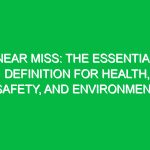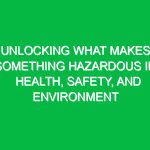Welcome to Today’s Toolbox Talk
Good morning, team! Thank you for gathering here today. As we prepare to start our workday, I want to take a moment to discuss a critical topic that affects all of us: Two Types of Workplace Stress within the Health, Safety, and Environment (HSE) domain. Understanding these types of stress is crucial not only for our personal wellbeing but also for maintaining a safe and productive work environment.
What Are the Two Types of Workplace Stress?
Workplace stress can be broadly categorized into two main types: acute stress and chronic stress. Both types can have significant impacts on our health, safety, and productivity, making it essential to recognize and address them effectively.
Acute Stress
Acute stress is the immediate reaction to a specific event or situation. It’s often characterized by the “fight or flight” response. For example, if you experience a tight deadline, a sudden change in a project, or a near-miss incident on-site, you might feel an intense rush of anxiety or stress. This type of stress is typically short-lived and can sometimes enhance performance by providing the necessary adrenaline to tackle the challenge at hand.
Real-Life Example of Acute Stress
Imagine you are working on a construction site, and you suddenly hear a loud crash nearby. Your heart races, and you feel a surge of adrenaline. This acute stress response can help you react quickly to assess the situation and ensure everyone’s Safety. However, if acute stress is not managed properly, it can lead to more significant issues.
Chronic Stress
Chronic stress, on the other hand, is the result of prolonged exposure to stressors. This could stem from ongoing pressures at work, such as a demanding workload, difficult working conditions, or unresolved conflicts with colleagues. Unlike acute stress, chronic stress can lead to serious health problems such as anxiety, depression, and physical ailments.
Real-Life Example of Chronic Stress
Consider an employee who consistently works overtime without sufficient breaks. Over time, this constant pressure can lead to chronic stress, resulting in burnout, decreased productivity, and increased risk of accidents on the job. It’s essential to recognize these signs and seek help when needed.
Why Understanding Two Types of Workplace Stress is Important
Now that we’ve defined the Two Types of Workplace Stress, let’s discuss why understanding them is vital for our Workplace Safety and health.
Impacts on Health and Safety
Both acute and chronic stress can significantly impact our physical and mental health. Stress can lead to fatigue, decreased focus, and impaired decision-making, all of which can contribute to workplace accidents. For instance, a stressed worker might overlook safety protocols or be less aware of their surroundings, increasing the likelihood of an incident.
Promoting a Safety Culture
By understanding these types of stress, we can foster a culture of safety. A workplace that prioritizes mental health not only enhances employee wellbeing but also reduces the risk of accidents. Encouraging open discussions about stress and its impacts helps create an environment where everyone feels supported.
Identifying Stressors in Our Workplace
Next, let’s identify some common stressors that might contribute to both acute and chronic stress within our workplace.
Common Stressors
- Workload: Excessive demands or tight deadlines can lead to acute stress.
- Job Security: Uncertainty about job stability can create chronic stress.
- Work Environment: Poor working conditions or lack of resources can increase stress levels.
- Interpersonal Conflicts: Difficulty in communication or conflicts with colleagues can lead to ongoing stress.
- Changes in Management: New policies or leadership changes can create uncertainty and anxiety.
Best Practices for Managing Workplace Stress
Understanding the Two Types of Workplace Stress is the first step; managing them effectively is the next. Here are some practical strategies to help reduce stress at work:
1. Recognize Stress Signals
Being aware of your body’s stress signals is crucial. Common signs include headaches, irritability, or difficulty concentrating. If you notice these signs, take a moment to assess your situation and determine if it’s related to acute or chronic stress.
2. Communicate Openly
Encourage open communication among team members. If you’re feeling overwhelmed, talk to your supervisor or a colleague. Sharing your experiences can help alleviate pressure and foster a supportive work environment.
3. Take Breaks
Regular breaks throughout the day can significantly reduce stress. Whether it’s a short walk, a few minutes of deep breathing, or a chat with a coworker, taking time to recharge can enhance focus and productivity.
4. Set Realistic Goals
Establish achievable goals for your daily tasks. Break larger projects into smaller, manageable steps, and prioritize your workload to avoid feeling overwhelmed.
5. Seek Professional Help
If stress becomes unmanageable, don’t hesitate to seek help from a mental health professional. Many workplaces offer Employee Assistance Programs (EAPs) that provide counseling and support services.
Creating a Supportive Environment
As a team, we can work together to create an environment that reduces stress. Here are some ways to do this:
1. Foster Team Spirit
Encourage camaraderie among team members. Social support is a powerful tool in managing stress. Team-building activities, both in and out of work, can strengthen relationships and create a sense of belonging.
2. Promote Work-Life Balance
Encourage a healthy work-life balance. Support each other in taking time off when needed and respect personal boundaries. A balanced lifestyle can significantly reduce chronic stress.
3. Provide Resources
Ensure that employees have access to resources for managing stress, such as workshops, seminars, or materials that address mental health and stress management techniques.
Regulations and Standards in HSE
Understanding the Two Types of Workplace Stress also involves recognizing relevant Regulations and standards. The Occupational Safety and Health Administration (OSHA) emphasizes the importance of providing a safe and healthy workplace, which includes addressing mental health issues. Compliance with these regulations not only protects employees but also minimizes legal liabilities for the organization.
Conclusion
To wrap up today’s Toolbox Talk, we’ve explored the Two Types of Workplace Stress—acute and chronic—and discussed their implications for our health and safety. Remember, recognizing and managing stress is essential for our wellbeing and productivity. By fostering open communication, supporting one another, and utilizing effective stress management strategies, we can create a safer and more positive work environment.
Thank you all for your attention today. Let’s carry these insights into our work and continue to prioritize our health and safety together. If you have any questions or would like to share your experiences, feel free to speak up now!


